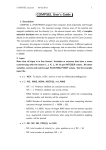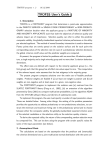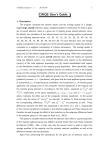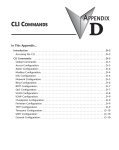Download COPOPS User's Guide
Transcript
COPOPS program 27/08/2010 1 COPOPS User’s Guide 1. Description COPOPS is a FORTRAN77 program that implements a decision aid for obtaining Pareto-optimal predictor subsets as described in De Corte, Sackett and Lievens (2010). The executable code is offered as is, without any guarantee whatsoever. Executing the code requires a key that can be obtained by mailing to the first author. The present program is limited to the followed conditions: (a) two selection goals, (b) the total number of feasible predictor subsets may not exceed 500, (c) only one minority group and only one job performance criterion, and (d) the maximum number of computed trade-offs per subset is 50. Observe that the program is computationaly very complex. Even with the above limitations, the execution time may take several minutes of CPU time, depending on the floating point performance of the computer. 2. Input Note that all input is in free format: Variables or vectores that have a name commencing with the letters I, J, K, L, M, N get INTEGER values. All other variables, vectors and matrices get FLOATING POINT values. See the example input file. • # 0: KEY • # 1: ITY, NP, IFWE, IBN – ITY: Controls the metric used to translate the selection quality and the selection diversity goal. ITY = 0: quality corresponds to expected job performance and diversity refers to the adverse impact ratio. ITY = -1: quality corresponds to the composite validity and diversity refers to the minority selection rate. – NP: total number of predictors (NP ≤ 10) – IFWE: IFWE controls the weighting of the predictors when forming composites. If IFWE = 0 then optimal weighting; if IFIWE = 1 then regression weighting; if IFIWE = 2 then unit weighting – IBN: IBN controls the number of Pareto-optimal solutions computed for each feasible predictor subset. The value of IBN must be between 10 and 50. Recommended value is 20. COPOPS program 27/08/2010 2 • # 2: NRWE, WMA. Only required if IFIXWE = 0!! – NRWE: If NRWE = 0, then the predictor weighting when forming predictor composites must obey a ratio constraint. No such ratio constraint if NRWE = 1. – WMA: The ratio between the largest and the smallest predictor weight when forming composites must be between 1/WMA and WMA. If NRWE = 1, a value for WMA must be specified, but the value is ignored. • # 3: SELR, COLIM, PMIN, CESMIN – SELR: Selection ratio of the selection – COLIM: Maximum total predictor costs – PMIN: proportion of minority applicants in the total applicant group – CESMIN: Criterion effect size (i.e., mean difference on the performance criterion between the minority and the majority applicant populations. If the mean criterion performance in the minority population is less than the mean performance in the majority population then CESMIN should have a NEGATIVE value; positive otherwise. • #4: PESMIN(I), I = 1, NP Vector of length NP with the effect sizes of the available predictors (all effect sizes are for the minority population relative to the majority population). • #5 and following NP-2 lines: Set of NP-1 lines specifying CP(I,J) (with I = 1, NP-1 and J = I+1, NP) the correlation matrix of the NP predictors. Note that the strict upper diagonal part of the correlation matrix must be specified! (see example) • #6: PVAL(I), I = 1, NP Vector of length NP with the validities of the available predictors • #7: PCOST(I), I = 1, NP Vector of length NP with the predictor cost PER APPLICANT of the available predictors • #8 MIP, MAP MIP: the minimum number of predictors that must be used in the composite; and MAP: the maximum number of predictors that can be used in the composite. COPOPS program 27/08/2010 3 • #9: ISP(I), I = 1, NP Vector of length NP with values of 0, 1, or 2. ISP(I) = 0 indicates that predictor I can not be used; a value equal to 2 indicates that the predictor must be used; a code equal to 1 indicates that the predictor can be used. 4. Sample Input File Important: in preparing the input file, use a simple text editor such as Notepad, Wordpad or any other standard ASCII producing editor. DO NOT USE TEXT PROCESSING PROGRAMS SUCH AS MS-WORD or WORDPERFECT. Also, when saving the input file in Notepad, use the option “All Files” in the “Save as type” box. When saving in Wordpad, use the “Text Document-MS-DOS Format” option in the “Save as type” box, and be aware that Wordpad has the nasty habit of adding the extension .txt to the file name that you specify. Thus, with Wordpad, if you specify the name of the input file as “MINPUT”, the file will in fact be saved as “MINPUT.TXT”; and this is the name that you have to use in the command to run the present programs. Here is a sample input file, for the copops program. KEY -1 9 0 20 0 10. 0.30 100. 0.20 -0.0 -1.008 -0.725 -0.684 -0.162 -0.992 -1.213 -0.797 -0.602 0.598 0.780 0.467 0.596 0.593 0.649 0.430 0.272 0.629 0.694 0.620 0.432 0.516 0.532 0.373 0.475 0.561 0.506 0.622 0.426 0.337 0.413 0.090 0.335 0.456 0.415 0.725 0.642 0.574 0.192 0.757 0.348 0.029 0.398 0.169 0.294 0.522 0.545 0.561 0.407 0.545 0.529 0.525 0.442 0.341 20. 10. 20. 10. 10. 15. 15. 20. 25. 1 3 1 1 1 1 1 1 1 1 1 -0.178 5. Running the Program Suppose you copied the executable code of the program to the C:ssel directory on your machine. In that case, the input file must also be saved in the C:ssel directory. Next, to run the program, you have to open an MS-DOS Command window. The way to do this varies from one operating system (i.e., XP, Vista, Windows 7 a.s.o.) to the other, and you should use your local “HELP” button when in doubt about this feature. If the MS-DOS Command window does not automatically open with the prompt C:\>, then you type in the MS-DOS Command window C:, followed by RETURN or COPOPS program 4 27/08/2010 ENTER, and your computer will return the C:\> command prompt. Next, you type cd ssel after the C:\> command prompt, again followed by RETURN or ENTER, and your computer will respond with the C:\ssel> command prompt. Now, you can execute the program by typing copops < minput > moutput where “minput” is the name of the input file and “moutput” is the name of the output file. At the end of the execution, the PC will return the command prompt C:\ssel>. You can then inspect the output by editing the output file with either Notepad, Wordpad or any other simple editor program. 6. Sample Output The output corresponds to the above input file. Only part of the output is printed. Other examples of the input and corresponding output files are available at the URL that contains the executable program. DATE: 26/08/2010; TIME: 11:11:46 THE PRESENT CODE IS FOR DEMONSTRATION PURPOSES ONLY!! +++++++++++ + COPOPS + +++++++++++ COMPUTATION of PARETO-OPTIMAL PREDICTOR SUBSETS Program written by W. De Corte, Ghent University, Belgium INPUT DATA AND DESCRIPTION SELECTION SITUATION Quality objective refers to the composite validity Diversity objective refers to the minority hiring rate Number of available predictors: 9 Number of applicant groups: 2 Proportional representation applicant groups First group is the Minority group: 0.200 0.800 Overall selection ratio: 0.300 Correlation matrix of the predictors: Predictor 1 1.000 0.598 0.780 0.467 0.596 0.593 Predictor 2 0.598 1.000 0.629 0.694 0.620 0.432 Predictor 3 0.780 0.629 1.000 0.475 0.561 0.506 Predictor 4 0.467 0.694 0.475 1.000 0.413 0.090 Predictor 5 0.596 0.620 0.561 0.413 1.000 0.725 Predictor 6 0.593 0.432 0.506 0.090 0.725 1.000 Predictor 7 0.649 0.516 0.622 0.335 0.642 0.757 Predictor 8 0.430 0.532 0.426 0.456 0.574 0.348 Predictor 9 0.272 0.373 0.337 0.415 0.192 0.029 Predictor Validities: Criterion 1 0.522 0.545 0.561 0.407 0.545 0.529 0.649 0.516 0.622 0.335 0.642 0.757 1.000 0.398 0.169 0.430 0.532 0.426 0.456 0.574 0.348 0.398 1.000 0.294 0.272 0.373 0.337 0.415 0.192 0.029 0.169 0.294 1.000 0.525 0.442 0.341 COPOPS program 5 27/08/2010 Effect sizes predictors in Minority group: -1.008 -0.725 -0.684 -0.162 -0.992 -1.213 -0.797 -0.602 -0.178 Effect sizes criterion in Minority group: 0.000 Predictor weights are optimized Ratio constraint on the within stage predictor weights: Max weight/Min weight equals 10.0 Total number of feasible predictor subsets is: 129 IDENTITY PREDICTOR SUBSETS Subset 1: Predictors 1 Subset 2: Predictors 2 Subset 3: Predictors 3 Subset 4: Predictors 4 Subset 5: Predictors 5 Subset 6: Predictors 6 LINES DELETED Subset 126: Predictors 6 Subset 127: Predictors 6 Subset 128: Predictors 6 Subset 129: Predictors 7 7 7 8 8 8 9 9 9 SORTED PARETO OPTIMAL QUALITY FOR PLOT USING R 0.4070, 0.4219, 0.4235, 0.4250, 0.4266, 0.4281, 0.4326, 0.4341, 0.4356, 0.4370, 0.4385, 0.4399, 0.4439, 0.4452, 0.4463, 0.4474, 0.4483, 0.4488, 0.4561, 0.4626, 0.4644, 0.4674, 0.4744, 0.4788, 0.4981, 0.5059, 0.5136, 0.5212, 0.5287, 0.5362, 0.5577, 0.5646, 0.5712, 0.5775, 0.5833, 0.5886, 0.5951, 0.5984, 0.6018, 0.6084, 0.6144, 0.6158, 0.6246, 0.6305, 0.6332, 0.6415, 0.6494, 0.6567, 0.6648, 0.6664, 0.6690, 0.4296, 0.4413, 0.4496, 0.4824, 0.5435, 0.5929, 0.6194, 0.6574, 0.4311, 0.4426, 0.4530, 0.4903, 0.5507, 0.5948, 0.6208, 0.6630, SORTED PARETO OPTIMAL DIVERSITY FOR PLOT 0.2562, 0.2536, 0.2533, 0.2530, 0.2527, 0.2515, 0.2512, 0.2509, 0.2506, 0.2503, 0.2489, 0.2486, 0.2482, 0.2478, 0.2473, 0.2394, 0.2383, 0.2379, 0.2360, 0.2354, 0.2240, 0.2202, 0.2163, 0.2123, 0.2083, 0.1916, 0.1872, 0.1827, 0.1779, 0.1729, 0.1544, 0.1539, 0.1529, 0.1474, 0.1415, 0.1320, 0.1255, 0.1251, 0.1179, 0.1105, 0.0925, 0.0833, 0.0810, 0.2521, 0.2496, 0.2404, 0.2317, 0.2001, 0.1616, 0.1349, 0.1016, 0.2518, 0.2493, 0.2396, 0.2279, 0.1959, 0.1582, 0.1329, 0.0939, USING R 0.2524, 0.2499, 0.2468, 0.2318, 0.2043, 0.1676, 0.1389, 0.1026, SUMMARY TABLE SELECTED PARETO-OPTIMAL SYSTEMS AND TRADE-OFFS Subset 4 35 35 Quality 0.407 0.422 0.423 Diversity 0.256 0.254 0.253 Predictor weights 0.407 (4) 0.404 (4) 0.040 (9) 0.403 (4) 0.045 (9) COPOPS program 35 35 35 35 35 35 35 35 35 35 35 35 35 35 35 35 35 35 35 119 99 119 119 99 119 99 118 99 99 99 99 99 99 99 99 99 99 99 99 99 99 99 99 99 97 99 118 97 97 97 0.425 0.427 0.428 0.430 0.431 0.433 0.434 0.436 0.437 0.438 0.440 0.441 0.443 0.444 0.445 0.446 0.447 0.448 0.449 0.450 0.453 0.456 0.463 0.464 0.467 0.474 0.479 0.482 0.490 0.498 0.506 0.514 0.521 0.529 0.536 0.543 0.551 0.558 0.565 0.571 0.577 0.583 0.589 0.593 0.595 0.595 0.598 0.602 0.608 0.614 6 27/08/2010 0.253 0.253 0.252 0.252 0.252 0.252 0.251 0.251 0.251 0.250 0.250 0.250 0.249 0.249 0.249 0.248 0.248 0.247 0.247 0.240 0.240 0.239 0.238 0.238 0.236 0.235 0.232 0.232 0.228 0.224 0.220 0.216 0.212 0.208 0.204 0.200 0.196 0.192 0.187 0.183 0.178 0.173 0.168 0.162 0.158 0.154 0.154 0.153 0.147 0.141 0.402 0.400 0.399 0.398 0.396 0.394 0.392 0.390 0.387 0.384 0.381 0.377 0.373 0.368 0.363 0.356 0.348 0.337 0.321 0.398 0.041 0.386 0.361 0.040 0.334 0.039 0.351 0.052 0.066 0.080 0.095 0.111 0.128 0.146 0.165 0.185 0.206 0.228 0.251 0.277 0.304 0.334 0.366 0.404 0.265 0.451 0.251 0.274 0.283 0.292 (4) (4) (4) (4) (4) (4) (4) (4) (4) (4) (4) (4) (4) (4) (4) (4) (4) (4) (4) (4) (3) (4) (4) (3) (4) (3) (4) (3) (3) (3) (3) (3) (3) (3) (3) (3) (3) (3) (3) (3) (3) (3) (3) (3) (3) (3) (4) (3) (3) (3) 0.050 0.056 0.061 0.067 0.072 0.078 0.085 0.091 0.098 0.105 0.113 0.121 0.129 0.138 0.148 0.159 0.172 0.187 0.208 0.040 0.413 0.039 0.036 0.395 0.041 0.348 0.040 0.347 0.346 0.344 0.342 0.339 0.334 0.329 0.323 0.316 0.308 0.298 0.286 0.273 0.257 0.237 0.214 0.183 0.327 0.138 0.351 0.309 0.287 0.260 (9) (9) (9) (9) (9) (9) (9) (9) (9) (9) (9) (9) (9) (9) (9) (9) (9) (9) (9) (8) (4) (8) (8) (4) (8) (4) (7) (4) (4) (4) (4) (4) (4) (4) (4) (4) (4) (4) (4) (4) (4) (4) (4) (4) (4) (4) (7) (4) (4) (4) 0.066 0.041 0.099 0.150 0.096 0.189 0.181 0.192 0.182 0.184 0.185 0.186 0.186 0.186 0.186 0.186 0.185 0.184 0.182 0.179 0.176 0.171 0.166 0.158 0.148 0.136 0.132 0.210 0.157 0.180 0.205 (9) (9) (9) (9) (9) (9) (9) (9) (9) (9) (9) (9) (9) (9) (9) (9) (9) (9) (9) (9) (9) (9) (9) (9) (9) (7) (9) (9) (7) (7) (7) COPOPS program 96 97 116 96 116 96 96 96 96 116 96 116 96 116 0.616 0.619 0.621 0.625 0.630 0.633 0.642 0.649 0.657 0.657 0.663 0.665 0.666 0.669 7 27/08/2010 0.139 0.135 0.133 0.132 0.125 0.125 0.118 0.110 0.103 0.102 0.094 0.092 0.083 0.081 0.311 0.301 0.385 0.310 0.379 0.307 0.303 0.296 0.287 0.343 0.273 0.318 0.247 0.274 (3) (3) (4) (3) (4) (3) (3) (3) (3) (4) (3) (4) (3) (4) 0.347 0.223 0.273 0.343 0.301 0.338 0.332 0.322 0.309 0.399 0.289 0.442 0.255 0.498 (4) (4) (6) (4) (6) (4) (4) (4) (4) (6) (4) (6) (4) (6) 0.120 0.236 0.246 0.145 0.247 0.172 0.202 0.235 0.273 0.239 0.319 0.231 0.381 0.213 (6) (7) (9) (6) (9) (6) (6) (6) (6) (9) (6) (9) (6) (9) CONTRIBUTION SUBSETS TO THE PARETO FRONT BASED ON B-SPLINE APPROXIMATION OF THE SUBSET FRONTS SUBSET 116 Diversity 0.0810, 0.0820, 0.0897, 0.0908, 0.0984, 0.0995, Quality 0.6690, 0.6688, 0.6662, 0.6657, 0.6604, 0.6595, SUBSET 96 Diversity 0.1008, 0.1026, 0.1158, 0.1177, 0.1308, 0.1326, Quality 0.6583, 0.6567, 0.6439, 0.6418, 0.6262, 0.6240, SUBSET 97 Diversity 0.1375, 0.1386, 0.1462, 0.1473, 0.1548, 0.1559, Quality 0.6177, 0.6169, 0.6097, 0.6085, 0.5994, 0.5979, SUBSET 99 Diversity 0.0831, 0.0842, 0.0853, 0.0864, 0.0875, 0.0886, 0.0919, 0.0929, 0.0940, 0.0951, 0.0962, 0.0973, 0.1006, 0.1007, 0.6685, 0.6682, 0.6679, 0.6675, 0.6671, 0.6667, 0.6651, 0.6646, 0.6638, 0.6631, 0.6622, 0.6614, 0.6585, 0.6584, 0.1045, 0.1064, 0.1083, 0.1102, 0.1120, 0.1139, 0.1195, 0.1214, 0.1233, 0.1251, 0.1270, 0.1289, 0.1345, 0.1364, 0.1374, 0.6551, 0.6534, 0.6516, 0.6497, 0.6479, 0.6459, 0.6398, 0.6376, 0.6353, 0.6332, 0.6309, 0.6286, 0.6215, 0.6191, 0.6178, 0.1397, 0.1408, 0.1418, 0.1429, 0.1440, 0.1451, 0.1483, 0.1494, 0.1505, 0.1516, 0.1527, 0.1537, 0.1570, 0.1581, 0.1586, 0.6160, 0.6150, 0.6141, 0.6130, 0.6119, 0.6108, 0.6073, 0.6061, 0.6048, 0.6034, 0.6020, 0.6008, 0.5964, 0.5949, 0.5942, COPOPS program 0.1587, 0.1909, 0.2229, Quality 0.5941, 0.5589, 0.5005, 8 27/08/2010 0.1627, 0.1668, 0.1708, 0.1748, 0.1788, 0.1828, 0.1869, 0.1949, 0.1989, 0.2029, 0.2069, 0.2109, 0.2149, 0.2189, 0.2269, 0.2309, 0.2349, 0.2380, 0.5924, 0.5893, 0.5856, 0.5813, 0.5764, 0.5710, 0.5651, 0.5525, 0.5457, 0.5387, 0.5315, 0.5240, 0.5163, 0.5085, 0.4924, 0.4839, 0.4758, 0.4641, SUBSET 119 Diversity 0.2381, 0.2383, 0.2395, 0.2397, Quality 0.4638, 0.4630, 0.4559, 0.4546, SUBSET 35 Diversity 0.2468, 0.2473, 0.2500, 0.2504, 0.2530, 0.2534, Quality 0.4488, 0.4484, 0.4398, 0.4381, 0.4250, 0.4231, 0.2384, 0.2386, 0.2388, 0.2390, 0.2392, 0.2394, 0.2399, 0.2401, 0.2403, 0.2404, 0.2405, 0.4625, 0.4615, 0.4604, 0.4591, 0.4579, 0.4566, 0.4533, 0.4520, 0.4507, 0.4496, 0.4494, 0.2477, 0.2481, 0.2485, 0.2489, 0.2493, 0.2496, 0.2508, 0.2512, 0.2515, 0.2519, 0.2523, 0.2527, 0.2536, 0.4477, 0.4467, 0.4455, 0.4441, 0.4427, 0.4413, 0.4363, 0.4344, 0.4326, 0.4309, 0.4289, 0.4268, 0.4219, SUBSET 4 Diversity 0.2562, 0.2562, Quality 0.4070, 0.4070, COVERAGE GLOBAL PARETO FRONT BY THE SUBSETS 99 96 116 97 35 118 119 34 0.4609 0.2630 0.1694 0.1358 0.0388 0.0222 0.0217 0.0108 CPU TIME IN SECONDS 34.41 7. Description of Output • COVERAGE GLOBAL PARETO FRONT BY THE SUBSETS: proportion of the global Pareto front (i.e., the front over all feasible predictor subsets) captured, or COPOPS program 27/08/2010 9 approximated very nearly, by the predictor subsets. Only subsets that contribute at least .001 are mentioned. 8. Acknowledgement When the user reports results obtained by the present program, due reference should be made to De Corte (2010) and De Corte, Sackett and Lievens (2010). 11. References De Corte, W. (2010). COPOSP User’s Guide. De Corte, W., Sackett, P., & Lievens, F. (2010). Selecting predictor subsets considering validity and adverse impact. International Journal of Selection and Assessment, 18, 260-270.




















